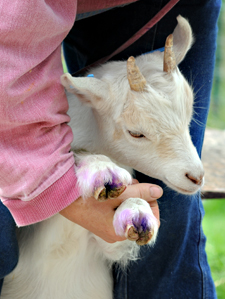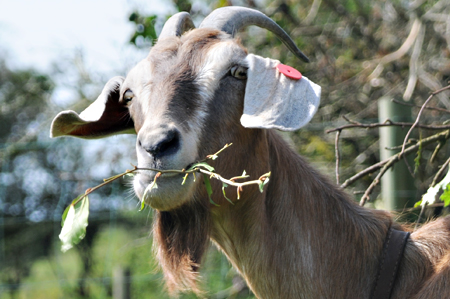Welcome to Relaxed Farming
- Alpacas
- Chickens
- Dairy Goats
- Ducks
- Geese
- Pigs
- Pygmy Goats
- Quail
- Rabbits
- Sheep
- Turkeys
- Polytunnel
- Photo Stories
- Video Stories
- Food
- Smallholding Map
- 2013
- 2014


- August
- September
- October
- November
- December
- January
- February
- March
- April
- May
- June
- July
- August


- 1
- 2
- 3
- 4
- 5
- 6
- 7
- 8
- 9
- 10
- 11
- 12
- 13
- 14
- 15
- 16
- 17
- 18
- 19
- 20
- 21
- 22
- 23
- 24
- 25
- 26
- 27
- 28
- 29
- 30
- 31
Sunday, 11th August 2013
Today we cut the goats' hooves: every few weeks we check them and if needs be give the nails a trim. A goat's hoof is made up of a soft pad (like the soles of our feet) enclosed on all sides (but not the bottom) in a hard shell of nail. A little like with humans, the nails on goats' hooves continually grow and if they are not cut or wear down naturally there is a danger they will split or curve: at best this makes it hard for the goat to walk, at worst the foot could become infected and sore. When trimming, the idea is to leave a good edge on the nail so that the goat walks on this edge rather than the actual pad of its foot which is much softer. And when all is done, a quick burst of the smallholders' anti-bacterial purple spray hopefully ensures the foot remains infection-free!
We also took the opportunity to tag this year's kids: this means putting a numbered tag in each ear - not our favourite job and judging by the screams from Pepper here (and our two female kids), not theirs either!!!
Curds (right hand photo) has a red tag as when we rescued her via the RSPCA four years ago, she was not tagged at all so we put a replacement tag on her. Tagging is a legal requirement and gives all livestock a unique identity, linked to the smallholding. This then means when animals are moved around or sold they can always be found. The main reason for doing this is so that if there is an outbreak of a nasty disease all animals can be traced so that the disease cause can be identified and then the spread of it stopped as soon as possible. Tagging is also useful for the individual farmer as it helps him/her keep accurate breeding records so that each year he/she only breeds from the best animals. Tagging does cause a small amount of pain (it is similar to piercing a human ear) so should be done quickly and accurately!


